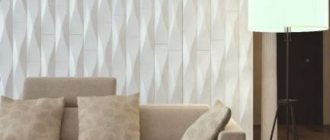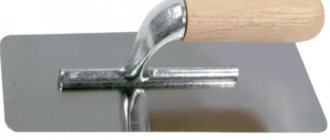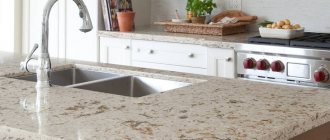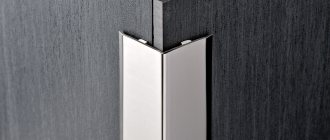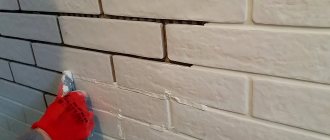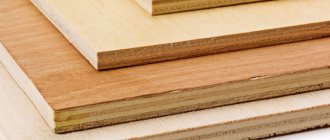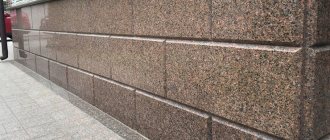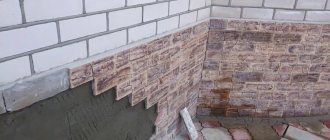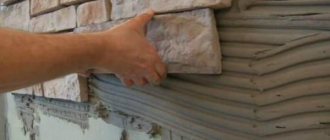How and with what to apply water repellent?
Hydrophobic impregnation is applied last, when all construction work is completed. This is done in several ways:
- With a brush. Product consumption is less, but work time increases.
- Spray. The cost is higher, the work goes faster. When sprayed, artificial stone and joints absorb more product and are therefore more protected.
Manufacturers recommend applying the water repellent while wearing protective glasses and gloves to prevent contact with skin and mucous membranes.
Tools
The set of tools largely depends on the tasks assigned. If you need to apply varnish to the decor around the doorway, a brush or sponge will suffice. If the amount of work is large, choose a roller or spray gun (airbrush). Spraying varnish for gypsum tiles under brick is convenient at high speed, while the composition is applied evenly, and the shade is the same at all points of the surface.
Avoid fluffy rollers and brushes made from natural materials. They will inevitably leave smudges, and the consumption of paint and varnish composition will be excessively large. Additionally, prepare the following tools and materials:
- Wipes (rags), degreasing solution.
- If you need sanding, you can't do without sandpaper or a sander.
- Impregnation (hydrophobic agent, not always necessary).
For varnishing you can use an airbrush Source ytimg.com
“Wet stone” effect as a decorative technique
Some water repellents can change the color of artificial stone due to the formation of a film. The color of the stone may become more saturated, like after rain. This effect has become very popular, so manufacturers began to produce special water repellents that create a “wet stone” effect. For example, Tiprom-M impregnation with the property of hydrophobization. This composition not only protects the stone, but also creates the effect of a wet surface. This impregnation can visually “update” the façade of a country house.
Briefly about the main thing
Gypsum is used to make beautiful and practical finishing materials - gypsum tiles and decorative stone. In order to maintain their attractiveness and improve their performance and decorative properties, varnishing with various compositions is used.
To create a protective layer, oil, acrylic and yacht varnishes are used. The desired composition is selected according to personal preferences: shade, reflectivity and other characteristics. Two layers of varnish are applied to the cladding, trying not to leave smudges. Before work, you need to prepare the necessary tools and study the instructions for applying paintwork.
Ratings 0
What's the result?
- 1.Hydrofobizator creates a protective film and extends the service life of artificial stone and seams, protects against the formation of efflorescence, fungus and mold.
- 2. The best water repellent for artificial stone is a solution based on organosilicon. But if you want to work at subzero temperatures, then use a composition based on silanes and siloxanes
- 3. Impregnation should be applied in 2 layers with a spray gun - using the “wet on wet” method. Particular attention is paid to the lower part of the facade, because it gets wet the most.
- 4.If the solution gets on adjacent surfaces - windows, frames or doors, wipe them with a damp cloth.
The assortment of the Unimart cybermarket includes a wide selection of water-repellent impregnations for artificial stone “Tiprom” and “Perfecta”.
Stone color enhancers, protective impregnations and coatings for stone
ALMIR Company LLC sells in Russia modern stone color enhancers, protective impregnations (water repellent, repellent) for stone and coatings for natural and artificial stone. They have the following properties:
► reduction of water and oil permeability of the surface;
► good weather resistance without yellowing;
► stability of action throughout the entire service life;
► water vapor permeability.
A protective agent (impregnation) is a liquid that, when used on stone and other materials (such as concrete, ceramics, etc.), prevents the penetration of water and dirt contained in the water. This type of protective drug is called a water repellent (from the Latin repello - I drive away, I push away). Some products can also prevent the formation of oil and other greasy stains (from food, cosmetics, etc.) For this reason, they are called water and oil repellents.
Indoors, unprotected stone is exposed to various liquids. For example, in the bathroom it is water, detergents, in the kitchen it is food, drinks, oils, fats, etc. Liquids leave stains that are difficult to remove completely. In commercial settings, especially in the food service industry, stone is exposed to even more intense contaminants. Often, the owners of premises that have stone surfaces do not even suspect that the stone can be protected at all. In this case, just a few months after the start of use, the floors, benches, and bar counters are full of stains of various origins that cannot be washed off with household products. Then the owners begin to wonder how to remove these stains. As numerous tests have shown, the treated surface absorbs much less liquid, and those stains that still remain are eliminated without unnecessary effort and almost completely.
It must be remembered that acid-containing products and household chemicals containing chlorine and acids damage marble, even protected marble.
For stone located outside, protection plays an even more important role. There are many more destructive factors here. Let's list some of them.
1. Freezing and thawing. Water that gets into the pores and freezes in them increases in volume and literally tears the stone apart. Therefore, it is important to prevent water from getting inside the stone.
2. Efflorescence. Salts escaping through the stone crystallize and destroy the stone at the micro level.
3. Algae, mold and various “biolife”. Everything that grows, blooms and takes root destroys any rock. And it is advisable to avoid this for those who want to preserve the stone.
4. Ultraviolet. It destroys coloring pigments, making the stone pale, “bleaching” the color. This effect is especially noticeable on beautiful contrasting varieties of marble.
Our product range includes a wide range of high-quality protective compounds, color enhancers and coatings for marble, granite and other natural and artificial stone. Many years of experience and support of our suppliers - leaders in the stone processing industry: BELLINZONI, GENERAL, TENAX, ILPA (Italy), AKEMI (Germany) / Bellinzoni, General, Tenax, Ilpa, Akemi makes it possible to choose a tool for all tasks related to working with natural stone - from trivial to the most complex!
Color Enhancement
“Enhance color” in the vocabulary of stone workers means making the color of the stone brighter, more contrasting, “alive.” Very often the customer wants to see the stone brighter than it actually is. Also, the need to enhance the color appears if the stone has become dull or faded in the sun, turned pale after polishing (was overheated), or has different shades in one batch.
In this case, special stone color enhancers are used. These are mainly colorless, solvent-based liquids containing various wax and silicone additives. Different products are used for polished and unpolished stone—for polished stone, color enhancers are much more fluid. Sometimes, but not necessarily, color enhancers are also stain protectants.
Some types of products not only enhance the color, but also slightly darken and tint the stone. Due to the particles of different densities contained in the stone, such tinting often appears in spots. After the product has completely dried, these stains become noticeable and spoil the appearance of the stone. Despite the fact that there is a means for removing tinting impregnations, they are very difficult to remove, so it is always necessary to do tests in advance on areas of different densities.
The supply of stone color enhancers, protective impregnations (water repellent, repellent) for stone and coatings for natural and artificial stone directly from manufacturers provides us with products of the highest quality, the latest developments and at a reasonable price. Our consultants will help you choose a stone impregnation that is suitable for your specific case, in the required volume, with the required characteristics. It is possible to make samples on your stones. The consultant can go to the site to conduct tests and study the problem.
You can always order a stone color enhancer and buy impregnation for stone, marble and granite inexpensively with delivery throughout Moscow and Russia for cash or by bank transfer from ALMIR Company LLC. We accept VISA and MASTERCARD cards, quickly prepare all the necessary documents and ship the goods.
Instructions for use
Impregnation or varnish is sold ready-made. If a more liquid composition is required, the substance can be diluted with a regular solvent. To perform painting, you should additionally purchase a paint brush. A roller will not work, as it will not allow the substance to penetrate into the small pores of the material.
To prevent the stones from being damaged during processing, it is worth carrying out the work in accordance with certain instructions:
- The surface to be treated must be free of debris and dust. You can sweep the area, but the best solution is a vacuum cleaner. Very dirty areas will need to be washed.
- Be sure to dry the brick, stone or tile base, since the varnish does not stick to wet stone, and subsequently does not dry.
- Several thin layers of the composition are applied at regular intervals. If the previous layer has not yet dried, then the next one cannot be applied.
- Brick and porous tiles sometimes require several additional layers of coating. They also need to be applied evenly.
- Let the treated tile stand for a while so that the coating is completely fixed, saturating all microcracks and chips. The required time for fixation is two weeks.
As a result of quality work, a rich color is obtained, and the coating segments become wet. Thanks to impregnation, the conditions for using coatings and decor made from natural materials are improved. The mineral composition of the stone and its properties are preserved, and geodesy is improved. Any person who does not have special skills and experience in repair work can cope with the application of the material.
How and how to cover wild stone on a stove or fireplace (1 video)
Types of materials
Impregnations for bricks against moisture are distinguished according to various criteria. For example, compositions containing organic solvents are intended or recommended for work only outside the premises. The table below presents a classification of hydrophobic compounds for brickwork according to composition with a brief description of the basic properties.
| Impregnation group | Basic Description | |
| Alkyl siliconates | Water acts as a solvent here. The main method of application is adding the product to the working mass for molding certain building materials. Disadvantage: strict adherence to instructions is required to prevent the appearance of efflorescence on the surface of the building. | Potassium samples are characterized by low cost, low efficiency, and partial pore blocking is observed. Recommended use for volumetric hydrophobization. |
| Sodium ones are in little demand due to the increase in volume from direct contact with water (the film swells). This composition is not recommended for use on brick walls. | ||
| N-siloxanes | There is a restriction on use - limestone and building materials with a high content of it. The best base options are silicate and ceramic bricks. After drying, the surface completely retains its original color. | |
| Silanesiloxanes | Such impregnations for bricks are considered the best in terms of water-repellent properties. They are also characterized by the ability to penetrate deeply into the base and exhibit the declared quality throughout the entire operational period. | |
Instructions for use
Impregnating agents are sold ready-made and can be immediately applied to the base. For application, select a brush; it will be able to thoroughly saturate the entire surface. Stages of work:
- The surface is cleaned of all types of dirt.
- Wait until the base is completely dry.
- Using a brush, treat the surface in several layers, each one should dry well before the next one.
- Complete drying may take 14 days; the base should be protected from moisture in the first 13-14 hours.
